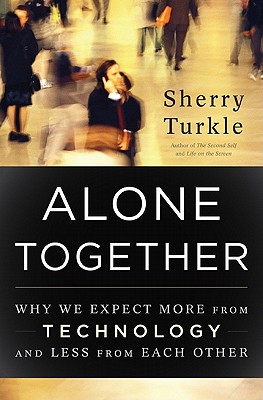Alone Together: Why We Expect More from Technology and Less from Each Other
Sherry Turkle

This was a great book, which is probably part of why it took me so long to write a review–I wanted to write something really insightful! However, I’m not going to do that, not least because it’s been three months or more since I read it.
Turkle is an MIT professor who has studied how people incorporate computers into their lives for decades–she started in the 70s I believe. So part of what I liked about this book is that it did not feel at all like a fluffy of-the-moment nonfiction book. It’s grounded in a research program that she has built her career on.
The book focuses on two aspects of the human-computer interface that ST has studied extensively: human interactions with human-like (and particularly, emotive) computers, and human-to-human interactions mediated by electronic technologies (basically, social media). These two topics seem fairly disjoint, but I think ST does a good job of tying them together. Most of us have much more experience with the latter than the former, but the former has something to teach us as well.
Turkle’s perspective struck me as very reasonable, and uncommon. She is not a hardcore tech-booster, and is very critical of those who talk about “what technology wants” and things of that nature; neither is she a Luddite, bemoaning the social ills of technology. Rather, her main wish is that we (both as individuals and as a society) should think reflectively about various technologies and the roles that they play in our lives, and take an active stance toward shaping that–saying no to some things and welcoming others in.
There’s such a wealth of interesting topics here that I’d hesitate to try to give any summary. However, the one thing I would highlight that she returns to repeatedly is the idea of something that goes from being seen as “good enough” to being seen as “better than.” These come up in both threads that she talks about, but probably the most familiar one to most of us would be texting–something that most people started out seeing as an ersatz phone call, which now, very many people prefer to an actual voice conversation. (And the statistics on how frequently teenagers text were astounding to me!) Again, I think she raises this in a very balanced way, not condemning it or lauding it, but suggesting the ways in which technologies have ended up shaping our preferences themselves.
I was a ready audience for this book, as someone who has tried to make some conscious choices about uses of technology in my life–but I think almost anyone would find a lot of food for thought in it.